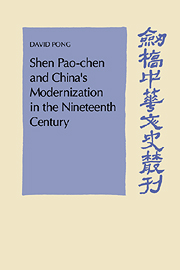Book contents
- Frontmatter
- Contents
- List of maps, tables, and figure
- Acknowledgements
- A note on spelling
- Abbreviations used in the notes
- Introduction
- 1 Early years
- 2 Local official in Kiangsi, 1856–1859
- 3 Governor of Kiangsi, 1862–1865
- 4 First encounters with foreigners
- 5 Director-general of the Foochow Navy Yard
- 6 The Foochow Navy Yard: early developments, 1866—1867
- 7 The Foochow Navy Yard: administration and personnel
- 8 The Foochow Navy Yard: building and training programmes
- 9 The Foochow Navy Yard: financial crises
- 10 The next steps in defence modernization: Ma-wei and beyond
- 11 Towards a plan for self-strengthening
- Conclusion
- Glossary of Chinese characters
- Bibliography
- Index
9 - The Foochow Navy Yard: financial crises
Published online by Cambridge University Press: 22 September 2009
- Frontmatter
- Contents
- List of maps, tables, and figure
- Acknowledgements
- A note on spelling
- Abbreviations used in the notes
- Introduction
- 1 Early years
- 2 Local official in Kiangsi, 1856–1859
- 3 Governor of Kiangsi, 1862–1865
- 4 First encounters with foreigners
- 5 Director-general of the Foochow Navy Yard
- 6 The Foochow Navy Yard: early developments, 1866—1867
- 7 The Foochow Navy Yard: administration and personnel
- 8 The Foochow Navy Yard: building and training programmes
- 9 The Foochow Navy Yard: financial crises
- 10 The next steps in defence modernization: Ma-wei and beyond
- 11 Towards a plan for self-strengthening
- Conclusion
- Glossary of Chinese characters
- Bibliography
- Index
Summary
Financing a modern defence undertaking, and the most expensive one at that, required much greater governmental intervention than did traditional enterprises. It called priorities into question – political, ideological, and financial. Whether a Western-style military or naval establishment was necessary or desirable had been debated since the time of the Opium War. A hostile political climate had once prevented Shen's father-in-law from openly promoting defence modernization. By the early 1860s, however, the situation had improved immeasurably. The Foochow Navy Yard experienced virtually no opposition from the gentry or the general population. On the contrary, it was Shen who led his fellow gentrymen in support of its creation. Then, in 1867, the first major political and ideological challenge (led by Wu T'ang and Wo-jen) had also been successfully overcome. And the qualified success portrayed in the preceding two chapters seems to suggest that not only had the political and ideological problems been resolved but the Navy Yard had also enjoyed adequate funding.
In a late-developing country, Dwight Perkins points out, the government must play an active part in promoting technological, industrial, and economic growth. But the Ch'ing government, whose revenue represented no more than 3 per cent of the country's gross national product, was an ‘unbelievably weak instrument’ for playing this role.
- Type
- Chapter
- Information
- Publisher: Cambridge University PressPrint publication year: 1994



